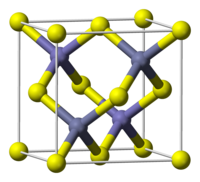Mercury telluride
 |
|
| Names | |
|---|---|
|
Systematic IUPAC name
Mercury telluride
|
|
| Other names
Mercuric telluride, mercury(II) telluride
|
|
| Identifiers | |
|
12068-90-5 |
|
| 3D model (Jmol) | Interactive image |
| ECHA InfoCard | 100.031.905 |
| EC Number | 235-108-9 |
| PubChem | 82914 |
|
|
|
|
| Properties | |
| HgTe | |
| Molar mass | 328.19 g/mol |
| Appearance | near black cubic crystals |
| Density | 8.1 g/cm3 |
| Melting point | 670°C |
| Structure | |
| Sphalerite, cF8 | |
| F43m, No. 216 | |
|
Except where otherwise noted, data are given for materials in their standard state (at 25 °C [77 °F], 100 kPa).
|
|
|
|
|
| Infobox references | |
Mercury telluride (HgTe) is a binary chemical compound of mercury and tellurium. It is a semi-metal related to the II-VI group of semiconductor materials. Alternative names are mercuric telluride and mercury(II) telluride.
HgTe occurs in nature as the mineral form coloradoite.
All properties are at standard temperature and pressure unless stated otherwise. The lattice parameter is about 0.646 nm in the cubic crystalline form. The bulk modulus is about 42.1 GPa. The thermal expansion coefficient is about 5.2×10−6/K. Static dielectric constant 20.8, dynamic dielectric constant 15.1. Thermal conductivity is low at 2.7 W·m2/(m·K). HgTe bonds are weak leading to low hardness values. Hardness 2.7×107 kg/m2.
N-type doping can be achieved with elements such as boron, aluminium, gallium, or indium. Iodine and iron will also dope n-type. HgTe is naturally p-type due to mercury vacancies. P-type doping is also achieved by introducing zinc, copper, silver, or gold.
HgTe bonds are weak. Their enthalpy of formation, around −32kJ/mol, is less than a third of the value for the related compound cadmium telluride. HgTe is easily etched by acids, such as hydrobromic acid.
Bulk growth is from a mercury and tellurium melt in the presence of a high mercury vapour pressure. HgTe can also be grown epitaxially, for example, by sputtering or by metalorganic vapour phase epitaxy.
Recently it was shown both theoretically and experimentally, that mercury-telluride quantum well shows a unique new state of matter—the "topological insulator". In this phase, while the bulk is an insulator, current can be carried by electronic states confined close to the sample edges. Unlike the quantum hall effect, here no magnetic field is required to create this unique behavior. In addition, oppositely directed edge states carry opposite spin projections.
...
Wikipedia
